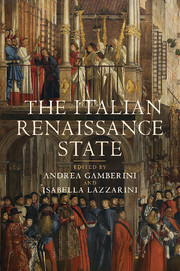Book contents
- Frontmatter
- Contents
- Notes on the contributors
- Note on translations and usage
- Map
- Introduction
- Part I The Italian states
- Part II Themes and perspectives
- 12 The collapse of city-states and the role of urban centres in the new political geography of Renaissance Italy
- 13 The rural communities
- 14 Lordships, fiefs and ‘small states’
- 15 Factions and parties: problems and perspectives
- 16 States, orders and social distinction
- 17 Women and the state
- 18 Offices and officials
- 19 Public written records
- 20 The language of politics and the process of state-building: approaches and interpretations
- 21 Renaissance diplomacy
- 22 Regional states and economic development
- 23 The papacy and the Italian states
- 24 Justice
- Bibliography
- Index
19 - Public written records
Published online by Cambridge University Press: 05 August 2012
- Frontmatter
- Contents
- Notes on the contributors
- Note on translations and usage
- Map
- Introduction
- Part I The Italian states
- Part II Themes and perspectives
- 12 The collapse of city-states and the role of urban centres in the new political geography of Renaissance Italy
- 13 The rural communities
- 14 Lordships, fiefs and ‘small states’
- 15 Factions and parties: problems and perspectives
- 16 States, orders and social distinction
- 17 Women and the state
- 18 Offices and officials
- 19 Public written records
- 20 The language of politics and the process of state-building: approaches and interpretations
- 21 Renaissance diplomacy
- 22 Regional states and economic development
- 23 The papacy and the Italian states
- 24 Justice
- Bibliography
- Index
Summary
Introduction
As with European monarchies, so with Italian states of the Renaissance (from the fourteenth century to the beginning of the sixteenth), abstract models of a homogeneous sovereignty exerted over a territory by a central power cannot be imposed. In the ‘long Renaissance’, the form these states took is rather that of a composite reality, an open field in which different institutional subjects, dealing at the same time with the centre and each other, are apportioned significant quotas of sovereignty and important public functions. Simply put, this is one of the innovations of the past thirty to forty years which this book intends to demonstrate.
No reminders are needed of the close connection between ‘written records and power’; any public authority, if it is to be considered legitimate and exercise social control adequately, must rigorously conserve, order and verify its written information. But rigour, exclusiveness and secrecy are what characterise the modern or contemporary state on achieving sovereignty. In the Italian Renaissance state, every different territorial institution corresponds specifically to the documentary sources it produces and preserves. There are many ‘public’ archives, and their characteristics reflect the actual structure of the state.
- Type
- Chapter
- Information
- The Italian Renaissance State , pp. 385 - 405Publisher: Cambridge University PressPrint publication year: 2012
- 4
- Cited by



